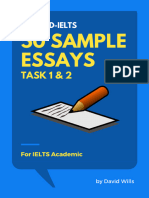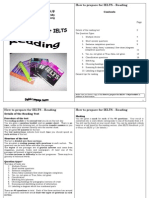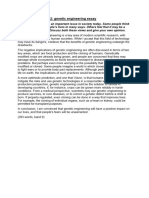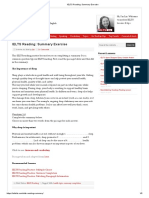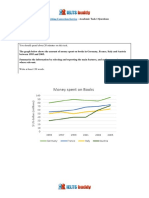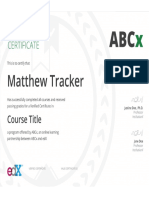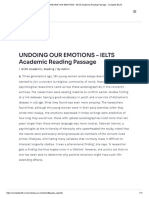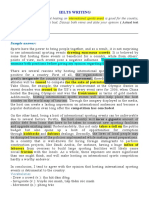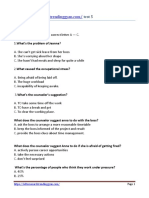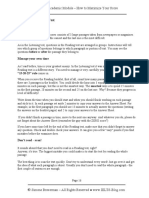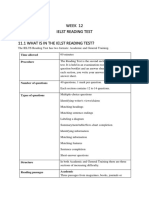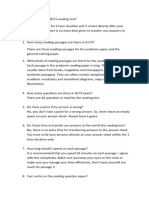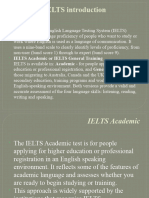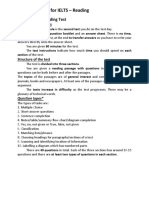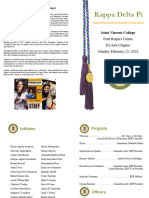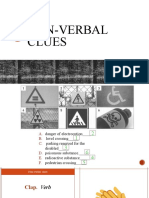THE FREE IELTS ACADEMIC READING TEST TUTORIAL
The Test Format
The IELTS Academic Reading Test has 3 sections. You have 60 minutes to complete the test. There is N
e!tra time at the end o" the test to trans"er #our ans$ers to the ans$er paper %#ou get &0 e!tra minutes in the
listening test onl#'( #our ans$ers must )e on the ans$er paper at the end o" the 60 minutes. The test has *0
+uestions )ased on a series o" 3 te!ts. The total length o" all the te!ts put together $ill )e )et$een ,000 and
,-.0 $ords. As in all the di""erent parts o" IELTS/ the Academic Reading Test gets progressivel# harder
through the paper. In each section o" the Academic Reading Test there $ill )e & te!t $ith &3 or ma#)e &*
+uestions to ans$er in , or 3 sets o" di""ering "ormats. 0e $ill loo1 at the t#pes o" +uestion that #ou $ill
meet later. The te!ts $ill come "rom maga2ines/ )oo1s and 3ournals and are $ritten "or general interest or
"or an academic though non4specialist reader. At least one te!t $ill contain a logical argument. ne te!t ma#
contain non4ver)al materials such as a diagram/ graph or illustration. I" there are an# $ords or terms o" a
specialist technical nature $hich candidates $ould not )e e!pected to 1no$/ then a short glossar# $ill )e
provided.
Marking
There are *0 +uestions in the IELTS Academic Reading Test and & mar1 is a$arded "or each correct ans$er.
There are no hal" mar1s. Your "inal mar1 out o" *0 is then converted to a )and "rom & 4 5 using a converting
ta)le and this )and is then averaged $ith the other 3 parts o" the test to give #our "inal IELTS )and. 6and
scores "or the reading test and the "inal )and are given as a $hole )and or a hal" )and. The converting ta)le
used to change #our mar1 out o" *0 to the )and out o" 5 changes $ith ever# test. 7o$ever/ )elo$ #ou can
see a rough guide that #ou can use to assess #our practice. There is no guarantee that #ou $ill per"orm the
same in the real test itsel" as the test converters var# $ith each test/ )ut it can )e a guide to #our progress.
IELTS Academic Reading Test Marks !ands and Res"#ts $ Ro"gh G"ide Con%erter
Score 6and
&
,43
*45
&04&.
&64,,
,34,8
,543.
36438
354*0
&
,
3
*
.
6
-
8
5
IELTS Academic Reading Test &"estion T'(es
6elo$ is a list o" the t#pes o" +uestion that #ou could meet in the IELTS Academic Reading Test. It9s use"ul
to read the list o" course/ )ut the onl# $a# to reall# )e "amiliar $ith the t#pes o" +uestion is through practice.
:lic1 here to go to the ;ractice ;age.
<ultiple choice +uestions
Short ans$er +uestions
:ompletion +uestions= :ompleting sentences
:ompleting notes
:ompleting a summar# %no $ord )an1'
:ompleting a summar# %$ith $ord )an1'
:ompleting a diagram
:ompleting a "lo$ chart
:ompleting a ta)le
<atching a )an1 o" headings to identi"# paragraphs or parts o" te!t
<atching a )an1 o" $riters9 vie$s>claims>in"ormation $ith the $riter
Identi"ication o" in"ormation in the te!t= #es>no>not given +uestions
true>"alse>not given +uestions
<atching lists>phrases
:lassi"ication +uestions
Some Ti(s )or the IELTS Academic Reading Test
?on9t spend too long on a single +uestion as that $ill lose #ou time "or ans$ering +uestions that could )e
easier "or #ou. Sometimes leaving a +uestion and coming )ac1 later can help #ou ans$er it too. Leave an#
+uestions that #ou have spent too long on/ and come )ac1 at the end o" the test i" #ou have time. Sometimes/
i" the +uestion has a #es>no>not given ans$er/ the ans$er #ou are loo1ing "or does not e!ist as it could )e a
not given. 6e a$are so #ou don9t $aste time loo1ing "or something that isn9t there.
Read the +uestions and instructions so #ou don9t ma1e a sill# mista1e. @or e!ample/ people o"ten $ill mi!
the #es>no ans$ers $ith the true>"alse ans$ers and $rite #es as an ans$er instead o" true or vice versa.
Strictl# spea1ing #ou are $rong although #ou have understood the +uestion and ans$er.
I" the +uestion as1s "or one ans$er then give one ans$er. Aiving t$o is $rong as it as1s "or one and #ou
$ill )e mar1ed $rong. The t#pe o" +uestion $here this could happen $ould )e= Aive one e!ample o"...
0riting t$o e!amples/ to sho$ #ou reall# understand/ is $rong.
I" the +uestion as1s "or no more than 3 $ords/ use no more than 3 $ords. 0riting * $ords or more is $rong.
You $on9t )e as1ed to do it in 3 $ords or less unless it is possi)le so don9t $orr#( it can al$a#s )e done.
ne area that students don9t li1e is that/ in the reading test/ good grammar and spelling are important. The
grammar part is not as important as #ou can9t ma1e man# grammar errors in 3 $ords %the ma!imum #ou use
in the reading test' )ut/ i" #ou spell something $rong/ it $ill )e mar1ed as $rong. ;eople thin1/ +uite rightl#
in m# opinion/ that the reading should test $hether #ou understand $hat #ou read and not ho$ #ou spell
something )ut these are the rules. So/ )e care"ul a)out #our spellingB
ne constant discussion I have had $ith students is $hether to read the +uestions "irst and then read the
passage or read the passage "irst and then the +uestions. @rom m# e!perience $ith man# students m#
conclusion is that there is no correct ans$er "or this. It depends on a num)er o" varia)les. It can depend on
the t#pes o" +uestion and ho$ di""icult the +uestions are. It can depend on ho$ good and "ast a reader #ou
are. It can depend on the length o" the te!t and ho$ much time #ou have. Let9s loo1 at these varia)les.
I" the +uestion t#pe is di""icult and as1ing something $hich is hard to ans$er then reading the te!t "irst can
help. Cust a +uic1 read through using a techni+ue called s1imming %see )elo$ "or an anal#sis o" s1imming'
can give #ou the 1no$ledge o" the te!t that $ill help #ou "ind the ans$er more easil#.
I" #ou are a good/ "ast reader/ then #ou can read the te!t +uic1l#/ getting good 1no$ledge o" the contents
$ithout using up too much precious time. This can help #ou ans$er the +uestions )etter.
I" the te!ts are short then it doesn9t ta1e long to +uic1l# read through them. n the other hand/ i" the te!ts are
short it is easier to "ind the ans$ers so #ou ma# not have to $aste time reading the te!ts to "ind the ans$ers
+uic1l#/ especiall# i" time is short.
I" time is short then it doesn9t matter ho$ comple! or long the te!ts are. You need to get some ans$ers on
the ans$er sheet as +uic1l# as possi)le. So/ #ou can see that there is not one ans$er to the pro)lem o"
$hether to read the te!ts or +uestions "irst. 0hat I tell students is to e!periment in #our practice and see
$hat suits #ou "or the di""erent t#pes o" +uestion in di""erent situations. As usual practising #our techni+ues
is the 1e#.
Time management is an important thing to )e a$are o". You have a num)er o" te!ts to read and *0 +uestions
to ans$er in & hour. I" #ou spend to long on one part/ #ou ma# "ind that #ou have not enough time to "inish
all the +uestions and some o" those +uestions could )e ones that #ou could ans$er +uite easil#. As I said
a)ove/ don9t spend too long on a di""icult ans$er )ut also 1eep an e#e on the cloc1. It9s a good idea to have
#our $atch or a small cloc1 on #our des1 so #ou 1no$ e!actl# ho$ long #ou have le"t in the test at an#
given time. In addition to this/ 1eep control on ho$ long #ou spend on each section. Remem)er the test gets
more di""icult as it goes on so #ou $ill pro)a)l# need more time "or the +uestions at the end than "or those at
the start. <a#)e a guideline could )e=
&- minutes on section &.
,0 minutes on section ,.
,3 minutes on section 3.
%I" #ou can do things more +uic1l# all the )etter as that $ill give #ou time to loo1 at +uestions that #ou
s1ipped and to chec1 on #our ans$ers'
0ith e!perience and practice #ou $ill soon 1no$ ho$ long things ta1e #ou/ and )e a)le to manage #our
time $ell.
As I 3ust said/ i" #ou have "inished the e!am $ith time to spare/ ?N9T 3ust sit thereBB :hec1 $hat #ou have
done. I" #ou have time a"ter the chec1/ chec1 again. And so on....
Reading Techni*"es $ Skimming and Scanning
S1imming and scanning are the t$o main techni+ues that people use to read and ans$er IELTS reading
tests. It9s not a +uestion o" using one or the other )ut #ou $ill need )oth methods in doing the test. Let9s have
a loo1 at the t$o techni+ues in turn.
Skimming
S1imming is reading "ast to get the DgistD or the general idea o" the te!t. There are di""erent techni+ues o"
doing s1imming. You can run #our e#es over the te!t getting the general meaning/ not stopping at $ords that
#ou don9t understand as this $ill slo$ #ou do$n. The important thing $ith s1imming is speed. Another $a#
to s1im is to 3ust read the "irst and last paragraphs o" a te!t and summaries as $ell. You could also 3ust read
the title/ su)titles and illustrations i" there are an#. I pre"er "or IELTS the "irst $a# 4 reading it all +uic1l# to
get the general meaning/ )ut o" course it depends on #our reading speed. I" #ou are a slo$ reader in English
#ou reall# need to practise to improve. You don9t need IELTS speci"ic te!ts "or this. A good English
ne$spaper is "ine. Aet one ever# da# and read the articles as +uic1l# as #ou can. ?o this $ith as man#
articles as possi)le ever# da# and #our speed $ill +uic1l# improve.
Scanning
This is another ver# important techni+ue "or the IELTS Reading Tests. This is the techni+ue that #ou use
$hen #ou are reading a telephone )oo1 or a dictionar#. You are not starting at the top and reading ever# line
)ac1 and "orth as #ou $ould read a novel. You are moving #our e#es around the te!t/ )ac1 and across and
up and do$n. You are searching "or some speci"ic in"ormation= a $ord or name. This is an important
techni+ue in IELTS reading as #ou are o"ten searching "or some speci"ic in"ormation. You read the +uestion
and then #ou search "or 1e# $ords or ideas associated $ith the +uestion. This is a )it more di""icult to
practise than s1imming. You get long te!ts %"rom ne$spapers/ maga2ines or other sources' and get a "riend
to read it and then as1 #ou to "ind 1e# ideas or $ords as +uic1l# as possi)le. Again/ i" #ou do this "re+uentl#/
#our speed $ill +uic1l# improve.
I" #ou $ant to improve/ there9s no secret. ;ractice. ;ractice. ;ractice. You $on9t get )etter sitting and doing
nothing. Even good English users need practice "or the IELTS e!am. It could ma1e all the di""erence
)et$een #our getting the )and that #ou need/ and getting hal" a )and less than #ou need and having to $ait 3
months to do the e!am again.
@inall#/ there are no correct ans$ers or methods. 7ere I9ve given #ou some ideas to guide #ou and hope"ull#
to help #ou )ut the +uestions can )e ans$ered $ell in di""erent $a#s. Aood luc1 $ith the IELTS Academic
Listening TestB I hope that this tutorial has helped #ou. 6elo$ are the lin1s to the other "ree Academic
tutorials.





